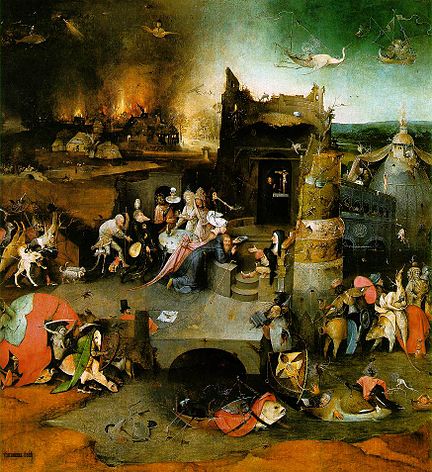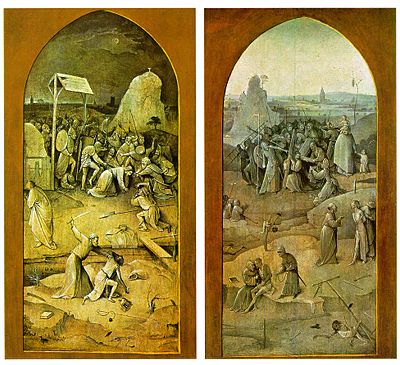The Temptation of Saint Anthony (Hieronymus Bosch)
The Temptation of Saint Anthony is a triptych by Hieronymus Bosch painted in oil on wood around 1500 , which has been exhibited in the Museu Nacional de Arte Antiga in Lisbon (1st floor, room 61) since 1913 under the inventory number 1498 . It measures 131.5 by 119 cm (middle part) and 131.5 by 53 cm (outer wing).
Significance and history
In the three-part, allusive altarpiece, Hieronymus Bosch interprets the popular theme of the temptation of Saint Anthony , a legend about Anthony the Great , which was recorded by the bishop, theologian and church historian Athanasius in his Vita Antonii in the middle of the 4th century . With the biographical narrative, he wanted to trace a monastic life in an ideal way. Since Bosch puts a witch's sabbath at the center of the picture, it is speculated that it could have been inspired by the Hexenhammer , which first appeared in Speyer in 1486 (one year later in Strasbourg ) , a dispute and judicial pamphlet by the Dominican monk and fanatical witch hunter Heinrich Kramer . This listed supposedly "unmistakable" characteristics of demonic figures and contributed greatly to the spread of superstition.
interpretation
The monk Antonius is shown on each of the three picture panels. On the left, he flies through the air with demons and, exhausted and unconscious, is carried over a bridge by companions. "Being on the way", the journey through life as such, is discussed here. In the middle picture, Antonius lives in a ruined castle and is tossed around by a wild, demonic event in which the devil takes part during his pious prayer. A diabolical fanatic hugs the monk, her headscarf tousled by the wind. Demons act as arsonists and are doing all they can to lay a village to rubble and ashes. "Unclean" animals and martial aircraft frolic in the air. On the right, the monk holds a book in his hand, turns his gaze towards the viewer with an unfathomable smile and thus turns away from the temptations to which he is “at the mercy”. A naked woman peeping out of a hollow tree trunk lures with her charms.
Overall, Bosch is presenting a pious “hallucination”, a shadowy dream world that is utterly obsessed with “evil” and in which there is apparently no escape from the unreasonable demands of war, violence and debauchery. The only “way out” of this earthly hell is indicated tentatively and dimly in the upper left image field: A ship with a billowing white sail seems to set off into another, possibly better world, very close to the edge of the image.
The interpretation of the individual motifs is controversial and leaves a lot of room for speculation. The attractive young man in the center of the picture, who is toasting a pig-headed knight and being accompanied by a ghostly woman, is interpreted as a devil who leads the witches' Sabbath and celebrates a “black mass” with the chalice. Lust and gluttony go wild. On the other hand, Antony's meditation before the crucified is almost completely out of sight. The pale light of the evening star hits Jesus . Old Testmentary scenes can be found on reliefs on the crumbling facade of the castle ruins, for example the dance around the golden calf and Moses carrying the Ten Commandments down from Mount Sinai. Christian motifs are reinterpreted demonically: The Three Wise Men are shown here as intoxicated demons riding on mugs, Mary and Joseph, also alienated in a ghostly manner, sit on a monstrous rat instead of a donkey. The profound insecurity and oppressive fears of the Old World in the Age of Discovery become clear when the gifted satirist Bosch populates his triptych with hypocrites, hypocrites, brutals, immoderate and coquettish. Beings in the air are interpreted as symbols of impermanence, should indicate mercury. All four elements of ancient teaching (fire, water, earth and air) are masterfully staged by Bosch. Sayings are also effectively implemented in pictures, such as “Big fish eat small fish”. Bosch also illustrates the literary original by Athanasius, sometimes surprisingly true to the text, for example when he interprets the quote from Antonius “Let an army besiege me, my heart will not despair” on the central panel as a lemur march. Medical historians also claim to have discovered examples of ergotism on the central panel of the Lisbon altar , also known as Antoniusfeuer , a mycotoxicosis (poisoning by ergot alkaloids in contaminated grain). What is meant is the seated "man with a high hat" on the left below the central scene with the devil. A rotten foot can be seen on a white cloth in front of the apparently amputee, possibly the sad sign of gangrene caused by eating ergot. Art critics point out that at Bosch, in contrast to the interpretations of many other artists, Antonius is not directly and physically tormented by ghost figures. Rather, the monk shows himself in contemplative calm in all images , the only exception being his flight with the demons.
Dating
The Austrian art critic Ludwig von Bardaß dated the triptych to the years 1505/06 and thus counted it among the mature late works of Bosch, who died in 1516. The Hungarian-American art expert Charles de Tolnay determined based on his style analysis an earlier date of creation around 1490, at least a creative phase before the triptych Garden of Earthly Delights and the hay cart .
Provenance
The Portuguese envoy and humanist Damião de Góis may have acquired the picture during his stay in Flanders (1523–1544), where he worked for King John III. was active. After his return, Góis is said to have given the triptych to the papal nuncio Giovanni Ricci da Montepulciano. Whether it fell into the hands of the Inquisition is controversial. After 1550, the work is said to have been in the care of the Spanish King Philip II , who could have acquired it in other ways. He inherited several Bosch paintings from his father Charles V and bought more from the widow of a courtier (Felipe de Guevara). The king kept a total of 13 Bosch works in the Escorial Palace from 1574 , including probably the Temptation of Saint Anthony . The work is said to have come to Portugal as a gift from the Spanish royal family. In any case, the three-part altarpiece has been in the Palácio das Necessidades in Lisbon since the middle of the 19th century , from where it came to the Palácio Nacional da Ajuda in 1912 until it was incorporated into the collection of the Museu Nacional de Arte Antigua a year later .
literature
- Ludwig von Baldass : Hieronimus Bosch , New York 1960
- Nils Büttner: Hieronymus Bosch , Munich 2012
- Stefan Fischer: In the maze of images. The world of Hieronymus Bosch , Stuttgart 2016
- Jos Koldeweij, Paul Vandenbroeck, Bernard Vermet: Hieronymus Bosch. The Complete Works , Stuttgart 2001
- Larry Silver: Hieronymus Bosch , Munich 2006
Web links
Individual evidence
- ↑ http://www.matriznet.dgpc.pt/MatrizNet/Objectos/ObjectosConsultar.aspx?IdReg=247559
- ^ Veit Harold Bauer: The Antonius fire in art and medicine , Berlin 1973, p. 80
- ^ Stefan Fischer: Hieronymus Bosch: Painting as a vision, teaching image and work of art , Cologne 2009, p. 306
- ^ Charles de Tolnay: The Complete Works. Hieronymus Bosch , Augsburg 1991, p. 27
- ^ Virginia Pitts Rembert: Hieronymus Bosch , Parkstone International, 2012, ISBN 978-1906981617 , p. 152
- ↑ http://www.matriznet.dgpc.pt/MatrizNet/Objectos/ObjectosConsultar.aspx?IdReg=247559



